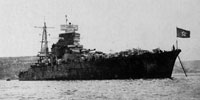 Fifty five years ago today, on October 29th 1955, the battleship Novorossiysk, flagship of the Soviet Black Sea fleet, moored in Sevastopol Bay, was shattered by a powerful explosion which caused the ship to capsize and sink. Over six hundred sailors lost their lives. The cause of the explosion remains a mystery to this day. The sinking itself remained classified until the late 1980s. Theories of what sank the ship include an explosion by a German limpet mine left over from WWII, a torpedo attack from an unknown submarine as well as sabotage by the Italians, the English or the KGB. So far no explanation has yielded a fully plausible explanation for the sinking. The ship was raised in 1957 and scrapped.
Fifty five years ago today, on October 29th 1955, the battleship Novorossiysk, flagship of the Soviet Black Sea fleet, moored in Sevastopol Bay, was shattered by a powerful explosion which caused the ship to capsize and sink. Over six hundred sailors lost their lives. The cause of the explosion remains a mystery to this day. The sinking itself remained classified until the late 1980s. Theories of what sank the ship include an explosion by a German limpet mine left over from WWII, a torpedo attack from an unknown submarine as well as sabotage by the Italians, the English or the KGB. So far no explanation has yielded a fully plausible explanation for the sinking. The ship was raised in 1957 and scrapped.
The mystery of the Novorossiysk
The Novorossiysk battleship was originally the Italian battleship Giulio Cesare. After coming off the assembly lines in Genoa in 1914, she was ceded to the Soviet Union as war reparations following the division of the Italian fleet between the Allied countries in 1945. The ship was commissioned in the Soviet Navy as Novorossiysk and served as a flagship of the Black Sea Fleet ever since.
By the evening of October 28th 1955 the ship had returned from naval exercises and some of the crew went ashore. Nearly 200 new recruits stepped aboard before supper.
The explosion left a 150 square-meter hole which quickly filled with water. The worst blow hit the forecastle deck where the recruits slept.
Nearly one thousand sailors were huddled on the upper deck. As the ship lurched sideways at a high speed, people rolled overboard followed by loose anti-aircraft systems and mechanisms.
All fleet top command was fired. A panel looking into the incident established that the explosion could not have been caused by a munitions blast because none of the weapons on board showed signs of damage. Eventually, the investigators settled for a ground mine version, even though all wartime mines discovered in the bay were non-operational.
A more theatrical explanation, that the explosion was staged by Italian frogmen avenging the transfer of the gem of the Italian fleet to the Soviet Union, was not substantiated by any evidence. In 1992, the Commander of the Italian Navy, Admiral Guido Venturoni, denied Italy’s involvement in the death of the Novorossiysk saying that the accident could not be blamed on Italian frogmen. He did not rule out, however, that Italian special services could have had a hand in it.
War historians suggest “the British connection”. After the war, the British kept the Giulio Cesare battleship in Malta. In those days the enemy ships, not yet split among the coalition countries, were mined, as Britain sought to weaken the fleet of a potential enemy. Experts say that the explosion might have been caused by a mine on the Novorossiysk’s hull floor, which went off ten years later. Other versions give other reasons for the disaster. But the cause will become clear only after all foreign archives have been declassified.
Thanks to Dave Shirlaw on the Marine History list for pointing out the article.
